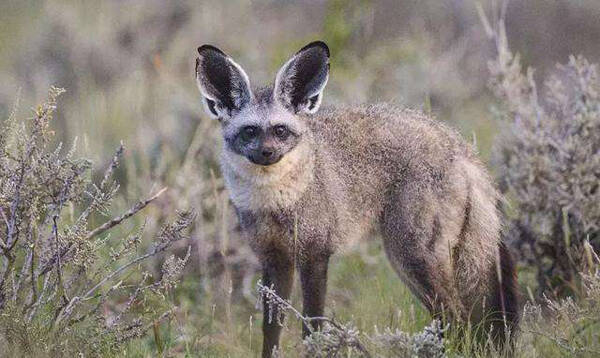Otocyon megalotis
IUCN
LCBasic Information
Scientific classification
- name:Otocyon megalotis
- Scientific Name:Otocyon megalotis,Bat-eared fox,Bat-eared fox, Cape fox
- Outline:Carnivora
- Family:Schizopoda Canidae Vulpes Viper
Vital signs
- length:46-66cm
- Weight:3-5.3kg
- lifetime:About 13 years
Feature
Bat-wing ears
Distribution and Habitat
Main distribution countries and regions: Angola, Botswana, Ethiopia, Kenya, Mozambique, Namibia, Somalia, South Africa, Sudan, Tanzania, Zambia, Zimbabwe.
Endemic to Africa, there are two subpopulations, one distributed in Somalia, Ethiopia and Kenya, and extending to other countries such as Tanzania and Uganda, and the other distributed in South Africa, Namibia and Botswana.
Inhabits arid grasslands and tropical savannas, preferring short grass areas. Lives in caves built by themselves or left by other animals. Caves generally have multiple entrances and dens, as well as tunnels several meters long.
Appearance
The name of the bat-eared fox comes from its huge ears, which are 114-135 mm long. The fur is mostly brown, the throat and abdomen are grayish white, and the outer edge of the ear is like a "mask" like a brown bear. The calves, claws, and tail tip are black. In addition to a pair of large ears, its unique tooth row is also different from other foxes. The bat-eared fox has 46-50 teeth, which is more than other heterodont placental mammals. Other dogs have no more than two upper molars and three lower molars, while the bat-eared fox has at least three upper molars and four lower molars. There is a large stepped digastric muscle protruding from the lower jaw, which is convenient for quickly chewing insects.
The head and body length of an adult fox is 46-66 cm, and the weight is 3.0-5.3 kg. The limbs are relatively short.
Details
The big-eared fox (scientific name: Otocyon megalotis) has bat-wing-like ears that can be up to 14 cm long. There are two subspecies. In fact, its species name "megalotis" comes from the Greek words "mega" and "otus", which means big ears.

In the Serengeti Plain, 85% of the activities of bat-eared foxes occur at night. In South Africa, they come out of their caves during the day in winter and in the evening in summer. Studies on the Serengeti Plain have found that the territory exclusively occupied by a bat-eared fox family is roughly 0.25-1.5 square kilometers, and the boundaries of the territory are marked with urine. Each family consists of a pair of parents and their offspring, who forage and rest together, often lie down and touch each other, groom each other, play and protect each other. In South Africa, the family territories of bat-eared foxes overlap widely, with few or no territorial marks. Sometimes 2-3 caves gather within hundreds of meters, and the population density can reach 10 per square kilometer, which may be related to the suitable soil or vegetation in the local area. The group life of bat-eared foxes helps to capture more termites, enhance prey detection, and provide opportunities for offspring to learn what to eat and how to hunt through imitation.
There are similarities between the play and escape behaviors of young foxes, because the demonstration behavior of adult foxes often shows escape rather than fighting.
The diet of bat-eared foxes mainly includes insects and other arthropods, occasionally small rodents, lizards, eggs, chicks and plants; termites and mayflies account for 80% of the food source. Termites that feed on the ground will be eaten by passing bat-eared foxes. They get a lot of water from the body fluids of these insects. Bat-eared foxes often appear around large herbivores such as wildebeests, zebras and buffaloes, using their large ears to listen for the movements of beetle larvae. Generally, they forage alone, but in places where insects are abundant, bat-eared foxes will also gather in large numbers. In fact, group foraging can catch more termites than foraging alone at the same time and place.
The bat-eared fox is a monogamous animal that breeds once a year. The newborn cubs open their eyes after 9 days and walk out of the cave after 17 days. The newborn cubs are covered with sparse gray fur. After 4-5 weeks, the fur color changes to the same as that of adults. The cubs have a lactation period of 15 weeks, and then follow their parents to go out for food. It takes 5-6 months to fully mature. After growing up, they mate separately. Male foxes guard, feed and play with their cubs for even longer than female foxes. The life span of captive bat-eared foxes is 13 years and 9 months.
The natural enemies of the bat-eared fox are jackals and eagles, and daytime birds of prey are the biggest threat. Common protected areas are in southern and eastern Africa. There are few protected areas in arid areas and farms in South Africa, where they are occasionally harmed. The size of the population in a local habitat depends on rainfall, food supply, gestation period and disease.
Listed in the 2008 IUCN Red List of Threatened Species ver 3.1 - Least Concern (LC).
Protect wildlife and eliminate game.
Maintaining ecological balance is everyone's responsibility!








